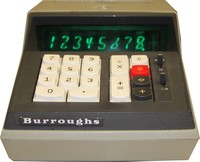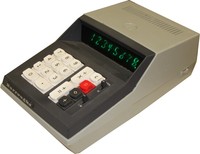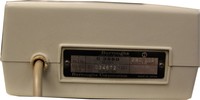Burroughs C3260 Electronic Calculator
| Home > Browse Our Collection > Calculators > Electronic Calculators > Burroughs C3260 Electronic Calculator |
|
This is Burroughs' rebranding (OEM copy from) the Sharp QT-8D electronic calculator, which was the first calculator to use MOS LSI (Metal Oxide Semiconductor, Large Scale Integration) integrated circuits, requiring only four of them for the calculator functionality. It was also the first calculator to use a vacuum fluorescent display (VFD) and was the smallest electronic calculator at the time. Introduced in 1971, the C3260 was marketed in America and Europe. It had also added features of memory function and the ability to perform calculations to 16 digits. It is a basic four-function, eight-digit floating decimal calculator with memory (or double-precision, depending on a mode switch). It uses individual Itron vacuum fluorescent display tubes for the display. Itron tubes use a unique segmented pattern to create digits that look more handwritten than the traditional 7-segment digit rendition.
Using the calculator: To multiply, the first number is entered, followed by the [÷X]" key, then the second number is typed in, followed by the [+=] key to calculate the product. The same sequence is used for division, but rather than pressing the [+=] key, the red key (with Burroughs' unusual "dot = dot" nomenclature) is pressed to perform the division. The keyboard panel has two slide switches to control the operational mode of the machine. The upper-most switch, with positions labelled "MEM" and "16", is used to select the operating mode of the machine. The 'MEM' and '16' slide-switch: The Burroughs C3260 has two operating modes. 'MEM' provides a memory accumulator, with a key to add the display to the memory [+], and one to recall the current content of the memory register to the display (diamond shape). "16" uses the memory register as a double-precision register, allowing results of multiplication and division operations to return answers up to 16 significant digits in length. In this mode, when a result is greater than 8 significant digits, the display shows the upper eight significant digits of the result upon completion of the calculation. The [diamond] key can then be pressed to display the lower eight digits of the result. When the lowest digits are being displayed, a single press of the [C] key will return the upper-most digits of the answer to the display. In "16" mode, the [+] key has no function. This double-precision mode is good only for use on single calculations...chain calculations in this mode result in the low part of the answer being lost, and answers that are of limited use. The 'CM' slide-switch (clear memory): The second slide switch is a momentary contact switch, used when the calculator is in "MEM" mode to clear the memory register. Sliding the switch downward to the "CM" position and releasing it causes the memory register to be set to zero. Manufacturer: Burroughs Other Systems Related To Burroughs C3260 Electronic Calculator:
This exhibit has a reference ID of CH35696. Please quote this reference ID in any communication with the Centre for Computing History. |
|













